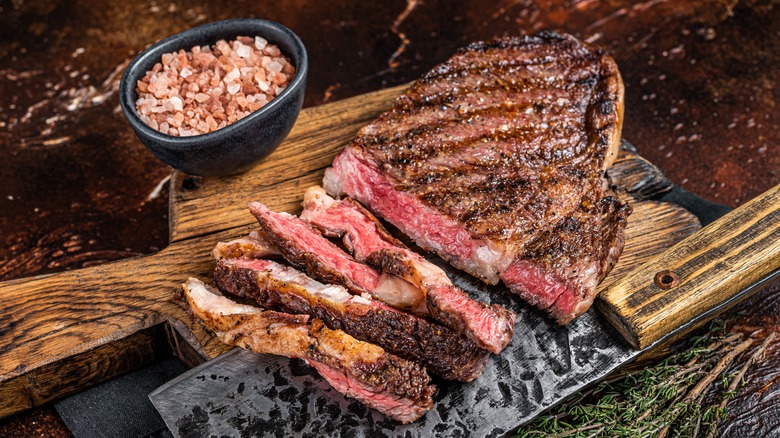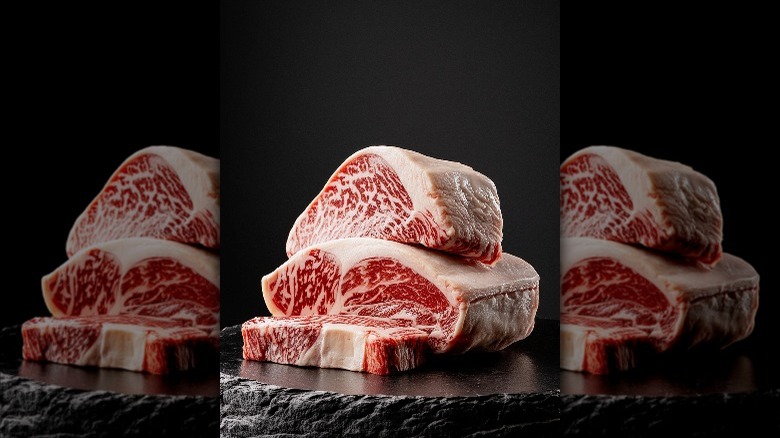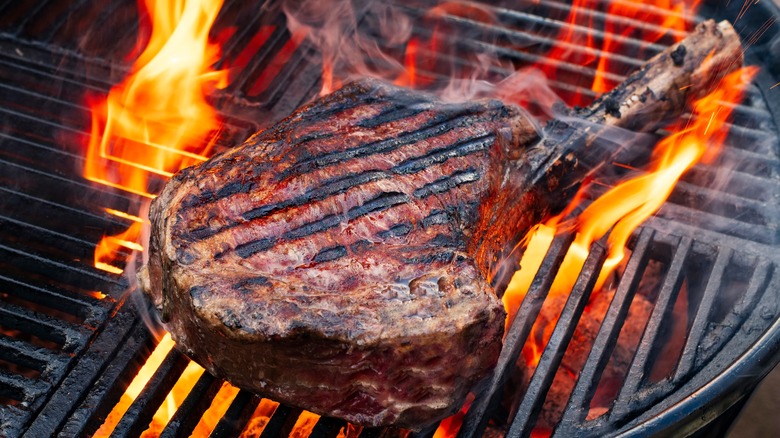A Steak Expert Explains Exactly How To Dry Age And Cook Perfect Wagyu Beef At Home
Dry aging beef is a time-consuming and difficult process with incredibly flavorful results. And while there are a number of great cuts of meat to dry age, there's simply no comparison to dry-aged Wagyu beef. We recently had a chance to get the full scoop on the matter while talking with K.C. Gulbro, owner of both FoxFire and Copper Fox and chef ambassador for Certified Angus Beef.
Wagyu beef is incredibly expensive thanks to its rich marbling, beautiful flavor, and limited supply. At the same time, dry aging is a difficult process to master and one which can completely ruin your meat if not done properly. It might be smarter to choose a more affordable cut of beef than Wagyu for your first attempt at dry aging, but Gulbro's tips are thorough enough to help anyone get their meat across the finish line.
"For dry aging at home, it's best to use a dedicated refrigerator that allows for airflow and maintains a temperature between 34 and 38 degrees [Fahrenheit]," Gulbro told Tasting Table. An entirely separate refrigerator is already asking for a significant investment of both money and storage space, but keep in mind that a mini-fridge is a viable option. "Keeping your meat in a designated refrigerator is strongly suggested to avoid cross-contamination or flavor transfers between products." Eggs, dairy, and vegetables in your fridge (alongside whatever else is stored inside) will alter the beef's flavor, which is something you want to avoid.
Dry aging uses time, temperature, and airflow to achieve a uniform crust
"Place the steaks on a wire rack so that air circulates around the meat, allowing for the muscle to dry evenly," Gulbro continued. Large cuts of steak are ideal for dry aging, but you can theoretically work with any size you want. The fat content of Wagyu will help reduce the risk of drying out, which is the problem that small cuts tend to run into. Using a humidifier and a fan can also help you dial in the proper environmental conditions for dry aging.
"Wrap your steak in mesh or cheesecloth to prevent the separation of proteins and help protect the meat," said Gulbro. "I would suggest a light wrapping of cheesecloth on Wagyu as the meat is so marbleized and delicate." The cheesecloth wrapping isn't so much a way to shield the meat from the outside air, as much as it's a way to help the beef retain its structure. You definitely don't want to wrap it so tightly that it begins to interfere with proper airflow.
"When dry-aging, you are developing flavor by properly drying your product, so airflow is important," Gulbro continued. "Rotate your meat every day to every other [day] to help even out the drying process." The whole endeavor can take anywhere from 14 to 45 days. Most people will aim for at least three weeks of aging, since the beef acquires more flavor the longer it stays in the fridge.
How to cook dry-aged Wagyu beef
Now that your Wagyu beef has been dry aged, it's time to savor the fruits of your labor. But just because your beef is dry aged doesn't mean that it's ready to be eaten; you'll still want to cook it. "You can cook your dry aged steaks on the grill or in a saute pan," explained Gulbro. "Dry-aged steaks cook differently, and the touch-temp method may not work the same on all cuts as the dry aging produces a hard exterior or pellicle." The touch-temp method that Gulbro is referring to is a way to check how well-done a steak is without cutting into it. Since that method doesn't work here, Gulbro has a different suggestion.
"Use a thermometer to properly temp your steaks," he said. Normally, you would want to "let your steaks rest before cooking, for 15 minutes to 1 hour, to achieve a more tender steak." But that's not the case here. "For Wagyu, be careful about resting before cooking, as the high-fat content may cause the steak to melt," Gulbro cautioned. If you have a habit of resting your steak before cooking, a few minutes is probably fine; but do it for less time than you normally would for the best results.
"I would always suggest cooking Wagyu rare to medium-rare ... but this is my preference," said Gulbro. "Cooking Wagyu well-done is a waste in my opinion." However you prefer it cooked, you now have the know-how to properly dry age steak at home.


